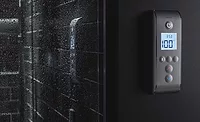Camera Tricks
But regardless of earthquakes, cameras not only identify the immediate problem, but also demonstrate upcoming difficulties. Cameras remove any doubt that work is needed.
With technology comes new tricks to make it work - common sense tips that aren't necessarily common practice. Keep these tricks in mind the next time you're in a jam.
How To Free A Stuck Camera
Camera cables do not rotate as do drain machine cables. As a consequence, they need help when they bind in a pipe. This technique is handy when you're having trouble traveling through a fitting or an offset connection in the line.Camera cables have interior fiberglass rods that give them rigidity so they can be pushed along. The major sticking point for a camera is when you are pulling out of a pipe through a bend.
If the camera head hangs up coming back through a fitting, try this:
- Bring the camera head up to the sticking point and locate exactly where it is with a line locator and mark the ground - just in case you lose the locating signal.
- Next, give the cable some slack by pulling a bit more cable out of the reel. Then push the camera in a bit to relieve the pressure on the camera head - just a few inches will do. Create a loop as shown in Figure 1.
- Now change the position of your hands to that shown in Figure 2. You should now have a "handle" to work with. Rotate the loop, hand over hand to build tension on the cable. At some point the torque will want to release itself. When it does, the camera head will spin slightly. At that precise moment, take a long, steady pull on the cable. The camera head will usually work its way out through the turn.
This technique takes practice to develop the right timing to synchronize the precise moment you should pull back on the camera. You should be pulling as the camera head is spinning. It may take a few attempts to free the camera head, but at least you don't have to dig down to get your camera out, which could be costly.
If the camera won't come out, try reversing the loop and turn the loop in the opposite direction. This will reverse the direction of the spinning camera.
Sleds, Skids, Centering Tabs & Brushes
In larger drains, (8-inch diameter and up) cameras that do not "pan and tilt" have difficulty seeing the full diameter of the pipe. Sometimes, you'll only see the bottom two-thirds of the pipe. Push-type cameras need to be lifted and centered on the pipeline.There are three ways to do this:
Let's get creative. With electrical tape, fasten the first few feet of your camera's cable to a length of rigid pipe. Use the pipe as a pole to push and guide the camera to where you want it to go. Use copper pipe with a bend in it to look around corners or get behind obstacles. I hear those wheels turning now!
As you unwind camera cable from its reel, the camera head rotates in the same way a garden hose spins as you unravel it.
Consequently, as you send the camera down a pipe your image on the monitor tends to rotate.
Many times it is helpful to decipher which way is up or down, if the pipe turns left or right or if it is turning downward and diving. Believe me, it's not always so obvious.
So what can you do to orient your image? Remember it could be upside down or sideways on the monitor. Very simple, really. Just run water down the pipe. The water will always be on the bottom of the pipe. As easy as it sounds, I didn't think of this little trick until I was in a jam.
In addition, keep in mind that a 2-inch pipe looks very different on your monitor than 3-, 4-, 6- or 8-inch pipe. Cast-iron also looks very different than clay, ABS or PVC pipe. Practice with short pieces of pipe of different sizes and dissimilar materials. When you get to a jobsite your diagnosis will be far more accurate. Then, he attached his camera to his jetter hose about 3 feet behind the jetter nozzle to make sure he was getting all the grease out of the system. The customer was so impressed he purchased a monthly preventative maintenance program at a cost of $3,000 every two months. The first contractor refunded the $3,500.
Take a lesson here. Commercial jetter jobs on long lines should always be checked with a camera before leaving the jobsite.The Pole Trick
This trick comes in handy for septic tanks and seepage pits. There are times when you just can't fit your body where the
pipes are or perhaps you want to investigate areas your shiny new camera was not designed for.
The String Trick
Reserve this trick for wells and any other vertical space. Tie a long string to the camera head. Hold the other end of the
string as you drop the camera down the flue. If you see a problem area, stop the camera and gently pull on the string and flex the camera cable to look around the pipe. You now get a better head-on view of any problems instead of using the camera's peripheral vision.Jetter Follow-Ups
A plumber I know was called out to alleviate a main sewer stoppage in a shopping mall that had just been jetted by one of his competitors at a cost of $3,500. He performed a video inspection with the owner present only to find a series of grease restrictions left by the first company.
Links
Looking for a reprint of this article?
From high-res PDFs to custom plaques, order your copy today!




